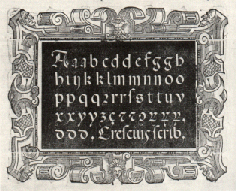September 16 - November 15, 1998
The Practice of letters:
The Hofer Collection of Writing Manuals, 1514-1800
Curated by David Becker & Anne Anninger
 Three centuries of rare printed manuals for teaching handwriting and lettering were shown at the Grolier Club from September 17-November 15, 1997. Seventy volumes dating from 1514 to 1800 were lent by the Houghton Library at Harvard University, selected from the collection given or bequeathed to Harvard by Philip Hofer (1898-1984), the former Grolier Club member, and renowned collector and scholar of the arts of the book. The Hofer Collection of more than 300 writing manuals places Harvard among the foremost collections of such material in the world.
Three centuries of rare printed manuals for teaching handwriting and lettering were shown at the Grolier Club from September 17-November 15, 1997. Seventy volumes dating from 1514 to 1800 were lent by the Houghton Library at Harvard University, selected from the collection given or bequeathed to Harvard by Philip Hofer (1898-1984), the former Grolier Club member, and renowned collector and scholar of the arts of the book. The Hofer Collection of more than 300 writing manuals places Harvard among the foremost collections of such material in the world.
With the advent of printing in the mid fifteenth century, the practice and teaching of handwriting and lettering went through revolutionary changes, much as the revolution in electronic communication is causing changes in today's world. By 1500, the demand for hand copying of lengthy manuscripts through the restrictive medieval craft system of scribes was drastically reduced. At the same time, however, the resultant increase in literacy (and bureaucracy) produced growing demands for personal, governmental, and commercial skills in handwriting. Writing masters saw an opportunity to transmit their methods of teaching lettering to a wider audience through carefully printed facsimiles of different handwriting styles. These could be used as models for a number of purposes, from sending personal letters to facilitating international commercial transactions to illuminating ecclesiastical decrees. In addition to examples of writing styles, the texts of these manuals often included instructions for cutting quills and mixing inks, recommendations for proper posture while writing and the best way to hold the pen in the hand, and step-by-step directions for making each stroke of a letter and combinations of letters.
The Grolier exhibition included the first such printed handwriting manual with woodcut illustrations, the 1524 Operina of Ludovico degli Arrighi (died ca. 1527), who was a scribe in the papal chancery in Rome. His samples of the so-called chancery cursive, often referred to as 'italic', formed an influential model for future writing masters, and also affected the design of subsequent italic printing types. The exhibition traced the development of this and other lettering styles through books printed in Italy, Spain, France, the Netherlands, and England, forming the basis of the common handwriting methods taught in elementary schools today. Also featured were handwriting manuals from Germany, Switzerland, and Austria that reveal the parallel development of the Germanic handwriting style variously known as fraktur, black-letter, or gothic. Prominent among the latter is a copy in contemporary binding of Ein gute Ordnung of 1538-43 by Johann Neudörffer the Elder (1497-1563), a famed Nuremburg writing master who collaborated with Albrecht Dürer on the latter's large-scale woodcuts. Neudörffer's book reveals his unique method of producing etched writing samples printed both in reverse and the proper direction.
In addition to the cultural and historical information that they convey about their period, writing manuals are quite often objects of great beauty. Such are the white-on-black woodcut samples by the Spanish master Juan de Iciar (ca. 1522-after 1572); the bravura complexities of pen designs by the Dutch calligrapher Jan van den Velde (1568-1623); or the familiar larger designs, often with illustrative vignettes, featured in The Universal Penman by the English engraver and writing teacher George Bickham, Senior (1684?-1758).
Since writing manuals were usually subjected to practical -- and very physical -- usage through tracing, cutting, copying and separation, they have survived in very small numbers. Several volumes in the Grolier exhibition are the only copies known of a particular title, such as the 1632 Exemplaerboeck of Pieter Le Prestre (born 1595), the rarity of which was discovered during the course of preparing this exhibition. Writing manuals have long been a major scholarly resource for calligraphers, typographers, and historians of letterforms. The everyday use of these manuals as textbooks for such a practical skill has brought scholars recently to study the transmission of cultural values, as reflected in the moralistic tone of many of the texts used as examples for copying, or the publication of manuals for specific audiences such as women or schoolchildren.
A 152-page catalogue by David Becker accompanied the exhibition.